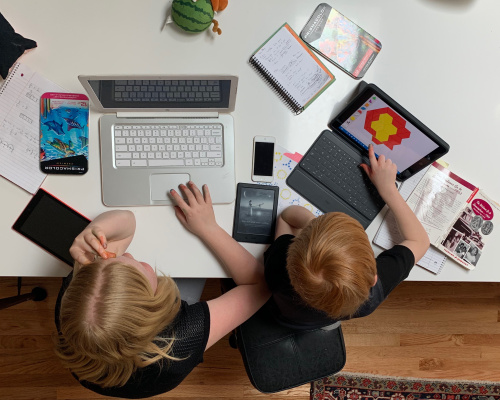I Screen, You Screen, We All Screen…
Date
My wife and I had a game plan for our children and their screens…at least we thought we had a plan until COVID-19 turned life as we know it upside down.
In the face of a global disaster, not a day goes by where I don’t stop to consider my family’s good fortunes. We are safe and healthy, my wife and I are still employed, and our children—at least for a few months—get to have us as their teachers. In fact, some life changes have been downright beautiful. This is, without a doubt, the longest stretch of continuous family time in my childrens’ lives. On Day One of school closures, our nine year-old son packed up and moved into the top bunk of his ten year-old sister’s room, seemingly for the long haul. As each others’ only present friends, the virus has brought them—and us—closer together.
At the same time, the pandemic has forced us to rethink many aspects of our parenting on the fly; the most alarming of which is our approach to screens in the house. Up until now, our children have always had access to devices at home. They have managed Google accounts for using the Internet and accessing G Suite tools. They have Kindle tablets for watching shows and playing the odd game, especially on long road trips. However, we tried to limit screen time to 30 minutes on the weekdays and our kids had no means for using devices to socialize with friends. Decisions on mobile phones were being postponed until at least sixth grade.
Overnight, our guiding principles on screens were thrown out the window. To create some sort of normalcy, we adopted a homeschool schedule, but many of these learning experiences required hands-on time with technology. In the past weeks, assignments have included designing geoboard quilt squares, composing emails to grandparents, and building Scratch games. The positive side effects of this screen time include visible improvements in basic tech skills, such as keyboarding. However, as productive as this time might be, to me, it is still time spent on screens.
Beyond extra screen time for learning, spending day after day trapped in the home—with the Oregon weather reliably grey, wet, and cold—naturally lends itself to a few extra movies and TV shows. I noticed that my own iPhone screen time has doubled, between extra news-reading and communications with my friends.
And it isn’t just me who is missing social interactions...our children quickly started missing their friends. The kids were using our phones to text, call, and FaceTime, so we set up Apple IDs and now both kids can reach out, socially. While we feel it is the right decision, it also meant that the time to have conversations about socializing on devices—conversations that we were saving until the kids were older—was right now.
Here are some of the ways we’ve been addressing the situation.
We are making sure that we build plenty of unplugged activities into our homeschool and home-life routines.
Managed IDs, such as those set up with Apple’s Family Sharing, come with a lot of parental controls. When my son’s iPad was “dinging” at 9:45 at night with a text message from a friend, we turned on Downtime, rendering the iPad unusable from 9 PM to 7 AM. Later, if the need arises, we can limit the usage of certain apps and turn on Communication Limits to control who they chat with.
For now, we’ve increased our daily screen time (outside of school-related tasks) to two hours. How they spend this time is up to them. Both kids learned quickly about prioritizing their tech use when they binge watched a TV series on Saturday morning, but then didn’t have time to chat with friends.
More than anything, we’ve been having a lot of frank chats about balanced and appropriate technology use. Together, with our son, we reviewed his weekly screen report from Apple. He noticed that on the days he used his device less, he felt happier. With our daughter, we sorted through the FOMO (Fear of Missing Out) feelings she had when a group of friends were video chatting and she wasn’t allowed to.
Keep in mind that our plan, like with pretty much all aspects of life today, is a work in progress. Tomorrow, and the changes it delivers, will surely force us to make adjustments.
Nellie Bowles of The New York Times recently declared that Screens Have Officially Won the Screen-Time Debate. In my family, that certainly seems to be the case. As the saying goes: if you can’t beat ‘em, join ‘em. Here’s to hoping that my family can make the transition in a way that helps my children develop into well-adjusted and responsible technology-using adults!

